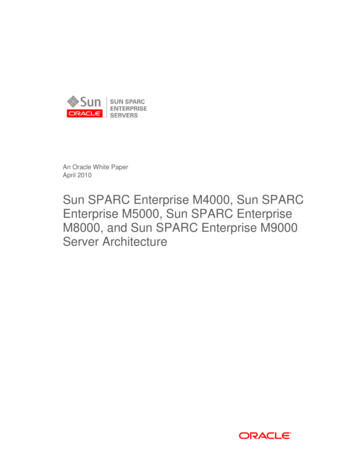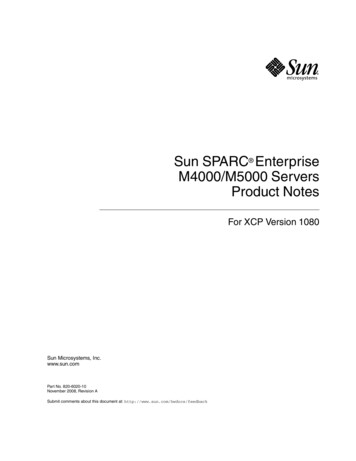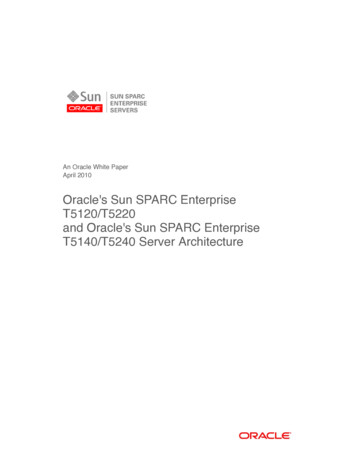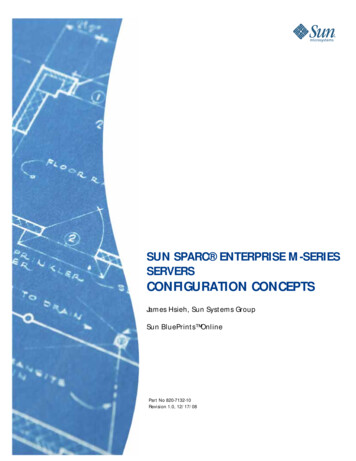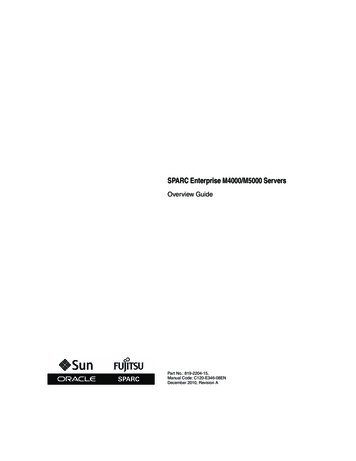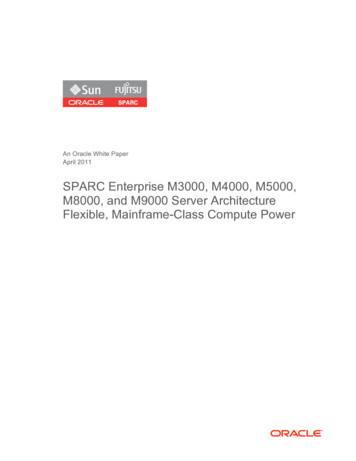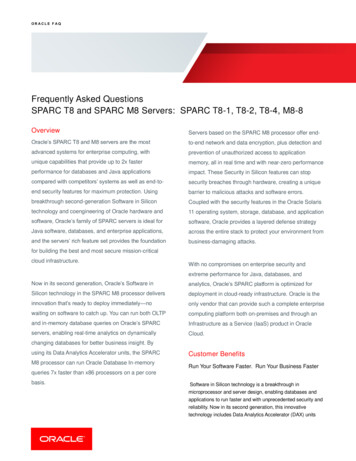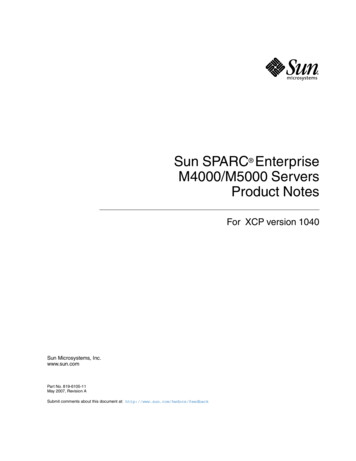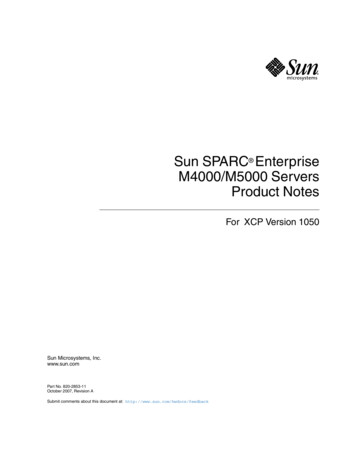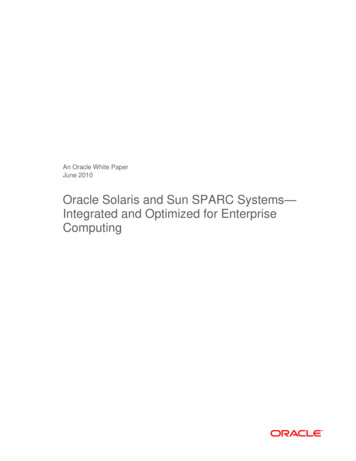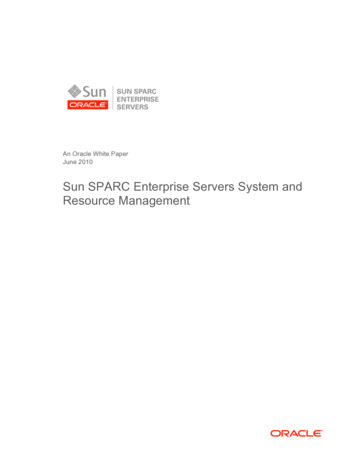
Transcription
An Oracle White PaperJune 2010Sun SPARC Enterprise Servers System andResource Management
Sun SPARC Enterprise Servers System and Resource ManagementIntroduction . 1Optimal Hardware for Consolidation . 2Managing Consolidated Applications . 3Managing Consolidation . 4Managing Sun SPARC Enterprise Servers. 4eXtended System Control Facility . 5Oracle Enterprise Manager Ops Center . 7Oracle Solaris Management Console . 12Configuration and Service Tracker . 13Sun Net Connect Services . 14Oracle Solaris: Support for Efficient Management . 15Simple Network Management Protocol Service. 19Managing Resources and Domains . 20Dynamic Domains . 21Dynamic Reconfiguration . 27Capacity on Demand . 34I/O Box . 35Fine-Grained Resource Management. 36Oracle Solaris Containers . 36Oracle Solaris Resource Manager . 38Managing Other Resources, Monitoring, and Accounting . 42User and Process Rights Management in Oracle Solaris . 42Resource-Capping Daemon . 42IP Network Multipathing . 43Managing Storage Resources in Oracle Solaris Containers. 44Oracle Solaris Fibre Channel and Storage Multipathing . 44Monitoring and Accounting . 45Conclusion . 47
Sun SPARC Enterprise Servers System and Resource ManagementIntroductionThough the importance of performance is indisputable, fast platforms alone are not enough torespond to the continually changing demands of today’s high-pressure, globally competitive,cost-sensitive business and technical environments, or to respond to rising power consumptionand other constraints in the datacenter. Sophisticated system, resource, and workloadmanagement tools are needed to harness the power of every system’s performance, flexibility,and availability. Oracle’s Sun SPARC Enterprise servers, with their complement ofmanagement tools, are designed specifically as general-purpose application, database, datawarehousing, and consolidation servers. They are especially suited to address the needs ofenterprise datacenters, with a goal of increasing performance and flexibility while consolidatingsystems to reduce datacenter costs and complexity.Applications are no longer simply standalone, but all of these applications on separate systemscreate a level of complexity both from the perspective of administering and maintaining them,as well as from the perspective of successfully integrating application services. The SunSPARC Enterprise servers help to manage consolidated applications by incorporatingadvanced manageability and innovative technologies designed to provide the agility to meetever-changing demands for capacity and performance. Examples of these capabilities includefifth-generation Dynamic Domains supported at the sub-board level, Dynamic Reconfiguration,Oracle Solaris Containers, and full system redundancy.The increased urgency and accelerated time frames of internal technical initiatives lead toserver sprawl, or the deployment of multiple single-purpose servers to achieve neededavailability or scalability. The result is underused resources and increased complexity.Consolidation collapses the functionality of multiple servers into a smaller number of systems,reducing costs and management complexity. The Sun SPARC Enterprise servers, togetherwith Oracle Solaris 10, offer an extensive array of system, resource, and workloadmanagement capabilities to allow IT organizations to reduce costs, decrease complexity, andrapidly respond to changes in demand.1
Sun SPARC Enterprise Servers System and Resource ManagementOptimal Hardware for ConsolidationThe Sun SPARC Enterprise servers are a uniquely robust class of servers equipped to manage the jobof consolidation and resource management (see Figure 1). The Sun SPARC Enterprise M9000 serveroffers the highest availability, highest absolute performance, highest scalability, and the mostsophisticated control of resources in Oracle’s extensive server product line. It supports up to 64 dualcore SPARC64 VI 64-bit processors (up to 128 cores), or up to 64 quad-core SPARC64 VII 64-bitprocessors (up to 256 cores), or combinations of SPARC64 VI and SPARC64 VII processors. It alsofeatures 2 TB of memory; 128 hot-swappable PCI Express (PCIe) I/O slots; up to 64 internal disks; anew high-performance interconnect capable of up to 737 GB/sec; and support for external I/O, up to24 domains, and thousands of software applications for the Oracle Solaris operating system (OS).Exhibiting 7.5 times greater system bandwidth than previous generations and scalability in everydimension, the Sun SPARC Enterprise M9000-64 server sets a new standard for performance andconfiguration flexibility in large symmetric multiprocessing platforms.Figure 1. Sun SPARC Enterprise server family.The SPARC64 VI processor contains two SPARC V9 cores running 2.15 GHz, 2.28 GHz, or 2.4 GHz;6 MB on-chip shared L2 cache; two vertical threads per core; and 128 KB of I cache and 128 KB of Dcache per core—and using the latest 90 nm process technology. It delivers up to 1.5 times theperformance of 1.8 GHz UltraSPARC IV processors, with the largest gains exhibited in transactionalworkloads. The SPARC64 VII processor contains four SPARC V9 cores running either 2.4 GHz, 2.52GHz, 2.53 GHz, 2.77 GHz, or 2.88 GHz, with up to 6 MB on-chip shared L2 cache, two simultaneousthreads per core, 64 KB of I cache and 64 KB of D cache per core, and using 65 nm processtechnology. It delivers 1.4 to 1.7 times the performance of the SPARC64 VI processor.The Sun SPARC Enterprise M9000-32 server offers high-end computing with a smaller system thanthe Sun SPARC Enterprise M9000-64 server, and the ability to upgrade to the Sun SPARC EnterpriseM9000-64 server by adding another cabinet. The Sun SPARC Enterprise M9000-32 server offers halfthe maximum configuration of the Sun SPARC Enterprise M9000-64 server and, consequently, lower2
Sun SPARC Enterprise Servers System and Resource Managementacquisition and operating costs. Supporting up to 32 CPUs (up to 128 cores), 2 TB of memory, 64 hotswappable PCIe I/O slots, 32 internal disks, external I/O, and up to 24 domains, the Sun SPARCEnterprise M9000-32 server is ideal for consolidation and mission-critical applications.The Sun SPARC Enterprise M8000 server is the entry system for the high-end Sun SPARC Enterpriseserver family. Using the same building block components used by the Sun SPARC Enterprise M9000servers, it is fully upgradeable to the Sun SPARC Enterprise M9000-32 server. The Sun SPARCEnterprise M8000 server supports up to 16 CPUs (64 cores), 1 TB of memory, 32 hot-swappable PCIeI/O slots, 16 internal disks, external I/O, and up to 16 domains.The Sun SPARC Enterprise server family also includes two midrange, rackmount systems—the SunSPARC Enterprise M4000 server and the Sun SPARC Enterprise M5000 server. These systems offeran economical price for the performance, enabling datacenter support for up to four domains andDynamic Reconfiguration, and featuring greatly improved reliability, availability, and serviceabilityfunctionality. The Sun SPARC Enterprise M4000 server’s six rack unit (6U) enclosure supports up tofour dual-core SPARC64 VI processors (8 cores), or up to four quad-core SPARC64 VII processors(16 cores), 256 GB of memory, two internal disks, external I/O, and two domains. The 10U SunSPARC Enterprise M5000 server supports up to eight dual-core SPARC64 VI processors (16 cores) orup to eight quad-core SPARC64 VII processors (32 cores), 512 GB of memory, four internal disks,external I/O, and four domains. Both systems feature a new higher-performance interconnect andindustry standard PCIe I/O, providing more than four times the memory bandwidth and 5 to 10 timesthe I/O bandwidth of UltraSPARC IV systems. All Sun SPARC Enterprise M-Series servers can mixSPARC64 VI and SPARC64 VII processors in the same system, as well as in the same domain. Mixingprocessor speeds is supported, without clocking down the faster CPUs.Managing Consolidated ApplicationsIn the past, datacenters focused on increasing predictability and discipline, while optimizing resourcesfor maximum efficiency to process static workloads. Today, predictability has given way to extremevolatility, thus changing many of the core requirements for system and resource management. Theadvent of the global economy, e-commerce, Web-centric services, mobile devices, and dynamicworkloads—along with the need to cut costs—is rapidly changing the computing environment.These days, applications are generally components in an application service that is likely to beintegrated into another application service. For example, an application service for a customerrelationship management (CRM) system typically consists of a database, an application server, and Webserver components, each deployed on its own server. The CRM system might then integrate with othersystems in the company, such as order entry or marketing systems—adding to an already complexsystem. Reducing the complexity of the infrastructure by introducing a consistent, consolidatedplatform can free IT operations staff to focus on more-strategic projects, enable resources to be sharedbetween applications for greater resource use, and provide a more-standardized environment tointegrate applications services to improve business processes.The Sun SPARC Enterprise servers offer the solution, delivering advanced reliability features, includinginstruction-level retry, protected static random-access memory and registers, extended error correction3
Sun SPARC Enterprise Servers System and Resource Managementcode (ECC) memory and mirroring, end-to-end ECC protection, hot-swappable components, andhardware redundancy—all at open systems prices.As consolidation platforms, the Sun SPARC Enterprise servers are easier to manage than similarsystems from competitors, due to the following advantages: The Sun SPARC Enterprise M9000-32 and Sun SPARC Enterprise M9000-64 servers offer 24hardware partitions or domains. The Sun SPARC Enterprise M4000, Sun SPARC Enterprise M5000, Sun SPARC Enterprise M8000,and Sun SPARC Enterprise M9000 servers support more than 8,000 Oracle Solaris Containers perdomain. The Sun SPARC Enterprise M4000 to Sun SPARC Enterprise M9000 servers require only oneOracle Solaris instance for thousands of containers, while competitors require one OS instance persoftware partition. Fewer instances are easier to manage. Oracle Solaris Containers is free, while partitions from competitors must be purchased.Managing ConsolidationThe problem of server sprawl not only requires greater capital investments, but it leads to significantlyhigher training, operational, and datacenter (floor space, heating, cooling) costs—as well as an inabilityto adapt to changing needs. Server consolidation can move the operation to a smaller number ofsystems while also increasing ROI by sharing existing resources across multiple applications. Serverconsolidation requires large servers that are capable of running more than one applicationsimultaneously, an OS with proven scalability, the ability to change and grow configurationsdynamically without impacting service, fine-grained control over system resources, and the ability toisolate applications from each other.Managing Sun SPARC Enterprise ServersOracle understands the difficult task that IT operators face today. Managers of large systems look forways to automate, integrate, and quickly adapt to manage ever-increasing and changing workloads.That’s why Oracle set out to make available a set of more-powerful management tools that simplifyadministration through streamlined procedures capable of enhancing existing skill sets. These toolsinclude the following: eXtended System Control Facility. This is a GUI-based or command-line interface (CLI)–basedset of system management applications. Oracle Enterprise Manager Ops Center. This a GUI-based single point of management forsystems, storage, and operating systems. Oracle Solaris Management Console. Perform administrative tasks involving users, projects, andjobs with this tool. Configuration and Service Tracker. This tool monitors hardware configuration changes.4
Sun SPARC Enterprise Servers System and Resource Management Sun Net Connect Services. These services enable self-monitoring, configuration and patchcollection, and reporting. Oracle Solaris features. These features enable upgrading of the OS and management of the systemand application services.eXtended System Control FacilityThe Sun SPARC Enterprise servers provide system management capabilities through the eXtendedSystem Control Facility (XSCF) firmware, which is preinstalled on the service processor boards. XSCFfirmware consists of system management applications and two user interfaces: XSCF Web, which is abrowser-based GUI, and XSCF Shell, which is a terminal-based CLI. XSCF Web uses the secureversion of HTTP and the Secure Sockets Layer (SSL) / Transport Layer Security protocols forconnection to the server, which is connected to a network. It also uses these protocols for Web-basedsupport of server status display, server operation control, and configuration information display.XSCF firmware is a single centralized point for managing hardware configuration, controlling thehardware monitor and cooling system (fan units), monitoring domain status, powering on/offperipheral units, and monitoring errors. XSCF centrally controls and monitors the server. XSCFincludes a partitioning function to configure and control domains. It has a function to monitor theserver through an Ethernet connection to enable remote control. It also reports failure information tothe system administrator.XSCF provides the following functions: Power control for the server system and domains. XSCF has power-on and power-off control ofthe server and temperature control by fan operation. The IT operator can press the power switchbutton on the operator panel to turn the whole system on or off, or to turn on and off the supply ofpower to the whole system or individual domains. Initial system configuration. XSCF configures the initial hardware settings of the XSCF unit andinitializes hardware to start the OS. It also controls the initial system configuration information. Internal cabinet configuration, recognition, and domain configuration control. XSCF displaysthe system configuration status, and it creates and changes domain configuration definitions. It alsoprovides domain start and stop functions. Dynamic reconfiguration. XSCF supports dynamic system board configuration change operationsand dynamic reconfiguration of a domain while the system is operating. Console redirection. XSCF provides a function that displays the Oracle Solaris console of eachdomain from XSCF through the LAN or serial port of the XSCF unit. With a secure shell (SSH) ortelnet connection to XSCF, the IT operator can use the OS console function. Component configuration recognition and temperature/voltage monitoring. XSCF monitorscomponent information such as the configuration status and the serial numbers of the componentsin the server. If an abnormality is detected in the component configuration, it is displayed and5
Sun SPARC Enterprise Servers System and Resource Managementreported. XSCF periodically monitors and displays the temperature inside the server, the ambienttemperature, component temperatures, voltage levels, and fan speeds. Firmware update. The Web browser and commands can be used to download new firmware, suchas XSCF firmware or OpenBoot programmable read-only memory firmware, without stopping thedomain. It can also be used to update firmware without stopping other domains. Monitoring server status and fault management. XSCF displays the status and, if necessary,degrades the faulty parts, degrades the faulty domains, or resets the system to prevent anotherproblem from occurring. Hardware fault information collection. XSCF collects hardware fault information quickly andsaves it on the XSCF itself. The XSCF hardware failure log makes it possible to identify the locationof a failure. The log also provides assistance in anticipating failures on the server and immediatelyreports precise information about failures. Support of hot-swapping components. XSCF supports maintenance work with XSCF Shellduring hot-swapping. Monitoring and notification during operation. Using the network function of the cabinet, XSCFaccesses the server to provide the following services: Monitoring the server even when the OS is inactive. Enabling remote operation of the server. Reporting error messages by e-mail to specified addresses. Trapping notification with the Simple Network Management Protocol (SNMP) agent functions.XSCF supports the SNMPv2 and SNMPv3 releases of management information base II (MIB-II)and the SNMPv1 release of MIB-I. Security. XSCF provides an encryption function using SSH or SSL. Any operation error orunauthorized attempt to access XSCF functionality is recorded in a log. Access details, such as whichusers logged in and the operations they executed, can also be recorded in an audit trail. Thisinformation can be used to troubleshoot system errors. XSCF user account control. XSCF controls the user accounts (system administrator, domainadministrator, operator, and field engineer) for XSCF operations. Capacity on Demand (COD) management. XSCF firmware provides setup and management ofCOD boards and COD permits. I/O box management. Displays I/O box information, configures the I/O box, and can power onand off specific I/O boards or power supply units.XSCF firmware has two networks for internal communication: the Domain to Service ProcessorCommunications Protocol (DSCP) and XSCF. The DSCP network provides an internalcommunication link between the service processor and the Oracle Solaris domains. The DSCP serviceprovides a secure TCP/IP–based and point-to-point protocol–based communication link between the6
Sun SPARC Enterprise Servers System and Resource Managementservice processor and each domain. Without this link, the service processor cannot communicate withthe domains.The XSCF network provides an internal communication link between the two service processors in ahigh-end Sun SPARC Enterprise M8000 server or a Sun SPARC Enterprise M9000 server. In a highend server with two service processors, one service processor is configured as active, and the other isconfigured as standby. This redundancy of two service processors enables them to exchange systemmanagement information and, in case of failover, to change roles. All configuration information on theactive service processor is available to the standby service processor.The SPARC Enterprise M-Series servers can be managed by Oracle Enterprise Manager Ops Center,or by third-party management tools. XSCF can communicate with the third-party tools using eitherbuilt-in SNMP or Oracle Enterprise Manager Ops Center software agents. This allows administratorsto simply add a Sun SPARC Enterprise M-Series server to their management tool of choice.Oracle Enterprise Manager Ops CenterOracle Enterprise Manager Ops Center allows IT administrators to actively manage and monitorinfrastructure resources from virtually anywhere on the network. Oracle Enterprise Manager OpsCenter simplifies the management of Oracle Solaris, Linux, and Windows using an advancedknowledgebase while enabling automated lifecycle processes. It also provides full lifecyclemanagement of virtual guests, including resource management and mobility orchestration. OracleEnterprise Manager Ops Center helps customers streamline operations and reduce downtime.Asset Management and DiscoveryOracle Enterprise Manager Ops Center automatically draws out the relationship between servers andtheir associated service processors to hypervisors and operating system instances. Assets can begrouped manually based on location or business function or a smart groups feature can automaticallysort the topology. Assets can be registered through inventory software services from Oracle, whichprovides details about the product’s lifecycle so the user can take appropriate actions.Simplified Provisioning ProcessAfter discovering and identifying systems and their components, Oracle Enterprise Manager OpsCenter can automatically filter through the operating system images and available firmware and presentonly those that are appropriate to the target system. Oracle Enterprise Manager Ops Centerautomatically creates and maintains the underlining technologies used during OS and firmwareprovisioning so administrators can focus on more important tasks. By having Oracle EnterpriseManager Ops Center deploy only the relevant firmware and operating system across larger and diverseasset groups, guesswork is eliminated. Oracle Enterprise Manager Ops Center also bridges the gapbetween the embedded Oracle VM Server for SPARC and its controlling domain by automaticallyverifying the appropriate firmware is installed. This process simplifies virtual machine creation later onand is completely transparent to the user.7
Sun SPARC Enterprise Servers System and Resource ManagementReduced Administrative CostsBy automating most of the deployment process for physical and virtual systems, user involvement isminimized. Oracle Enterprise Manager Ops Center offers a facility to create and store the approvedoperating system or firmware profile required by business services. Jumpstart, JET modules, kickstart,and yast customizations can be stored under named profiles to be deployed more easily later bypersonnel less familiar with the underlying technology. This allows the business to more efficientlyleverage IT skill sets across functional units.Rapid DeploymentOracle Enterprise Manager Ops Center deploys a complete stack on a bare-metal server to make thesystem production ready within a short time. It can create a snapshot of a system catalog and restore anoperating system to a previous state. It can compare inventories of multiple systems and make targetsystems match source inventories. This process can be applied to a single system, multiple systems, ormultiple datacenters. Since Oracle Enterprise Manager Ops Center has out of the box automation andin-depth knowledge of Oracle systems, operational staff can spend more time focusing on drivinggreater business value.Fault and Event ManagementHardware status and operating system performance is tracked to check the overall health of the system.When a predefined threshold or hardware condition is reached, a notification is sent to the userinterface and an e-mail is auto generated.Comprehensive ReportsOracle Enterprise Manager Ops Center’s rich UI and functionality presents information based on userdefinitions. Monitored information can be presented at a per-system/per-virtual resource level or canbe aggregated across a group of servers or virtual pools. Historical information for parameters such asCPU, memory, network I/O, and WATT consumption can be monitored and stored for futurereference. Moreover, any and all gathered data can be exported for further analysis or to create customreports.Automated Patching Using a Unique KnowledgebaseOracle’s Knowledge Services is a hosted metadata knowledgebase of Oracle Solaris, OracleUnbreakable Linux, Red Hat, and SuSE operating systems. This knowledgebase is a very powerfulcapability unique to Oracle. It is served down to customers through a web service or in a disconnectedmode. Leveraging the knowledgebase metadata improves patch accuracy and reduces downtime. Itmaintains advanced patch, rpm, and package dependency information that has been discoveredthrough unique methods exclusively owned by Oracle. Oracle Enterprise Manager Ops Center usesthis knowledgebase to download only the required patches the first time (not all new patches)—saving8
Sun SPARC Enterprise Servers System and Resource Managementboth network bandwidth and compute resources. It applies those patches and performs appropriateactions (single/multiuser mode, reboot option) as required (See Figure 2).Figure 2. Comprehensive reports cover patch requirements and gaps with other systems, enabling system updates and compliance.Reduce DowntimeOracle Enterprise Manager Ops Center helps system administrators meet their maintenance windowsin three ways. Leveraging its unique knowledgebase, the product first examines the installed softwareto see if any broken dependencies exist. Next it searches against vendor bugs, Common Vulnerabilitydatabases, or customer profiles to discover if updates are needed. With every action, it automaticallytakes snapshots of the inventory on the box in case rollbacks or time comparisons are needed. Itautomatically resolves required patch trees and groups them correctly during patch installation. Lastly,it will cache patch payloads on the agents and simulate installation to insure the operating systemcommands and directories are healthy enough to install additional software. Now the platform can bereliably patched with a higher level of confidence that nothing will go wrong. Oracle EnterpriseManager Ops Center will also automatically discover Oracle Solaris Live Upgrade alternate bootenvironments and display them for selection during patching allowing for zero downtime patching.ComplianceMultiple compliance reports are possible with Oracle Enterprise Manager Ops Center. Compare all the servers against a business project’s requirements. Compare against an older vendor provided baseline or always test against the latest information fromthe vendor. Test against a government approved common vulnerability database. Continuously schedule reports to help discover the server sprawl across the datacenter.9
Sun SPARC Enterprise Servers System and Resource Management Compare servers to one another or compare previous snapshots of the same server. Report who installed or uninstalled what, when, and where via Oracle Enterprise Manager OpsCenter.Manages Oracle Virtualization TechnologiesOracle Enterprise Manager Ops Center manages the lifecycle of Oracle Solaris Containers and OracleVM Server for SPARC. Their resources are monitored continuously to provide up-to-date informationon usage. Based on the dynamic needs of the applications, new Oracle Solaris Containers and OracleVM Server for SPARC virtual guests can be created, deleted, cloned, or reconfigured.Centralizes Management of ResourcesAs the central management console for all relevant infrastructures, Oracle Enterprise Manager OpsCenter tracks hardware, virtualization components, and operating systems. It provides the appropriatecomponents to keep physical and virtualization assets up to date. Oracle Enterprise Manager OpsCenter ensures that the system using Oracle VM Server for SPARC has the appropriate firmware.Lifecycle Management—Simple Deployment and MaintenanceWith Oracle Enterprise Manager Ops Center, you can install and manage all relevant components in avirtualized stack. Asset discovery. Oracle Enterprise Manager Ops Center can discover all assets, such as hardware,firmware, virtual systems, and operating systems. You can view them in a usable format. Provisioning. With Oracle Enterprise Manager Ops Center, you can provision firmware andoperating systems on bare-metal and virtual systems. Patching. With its unique knowledgebase, Oracle Enterprise Manager Ops Center keeps allcomponents (physical as well as virtual) in the stack up to date. Monitoring. Oracle Enterprise Manager Ops Center monitors physical and virtual systems toprovide end-to-end monitoring of the complete stack. It monitors individual as well as aggregateresources to get a complete view of the system.Eco-friendlyOracle Enterprise Manager Ops Center monitors the power of all servers and aggregates consumptionpatterns. Based on the outcome, administrators can balance the resources by shutting servers down,migrating workloads, or leveraging power capping capabilities in the servers.Reduces Resource Management ComplexityBy providing access to all assets, such as hardware, virtual systems, and operating systems (through oneinterface), Oracle Enterprise Manager Ops Center makes managing these resources simple. Assets can10
Sun SPARC Enterprise Servers System and Resource Managementbe logically grouped, automated through smart groups, tagged for custom grouping, and filtered withmultiple options.Investment ProtectionOracle Solaris 8 and Oracle Solaris 9 servers can easily migrate to Oracle Solaris 10. This allows OracleSolaris 8 and Oracle Solaris 9 implementations to leverage the latest capabilities in Oracle Solaris 10and newer servers. Virtual resource management is a seamless extension of
The Sun SPARC Enterprise M9000-32 and Sun SPARC Enterprise M9000-64 servers offer 24 hardware partitions or domains. The Sun SPARC Enterprise M4000, Sun SPARC Enterprise M5000, Sun SPARC Enterprise M8000, and Sun SPARC Enterprise M9000 servers support more than 8,000 Oracle Solaris Containers per domain.
